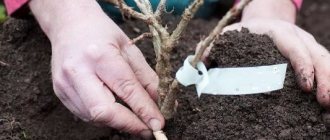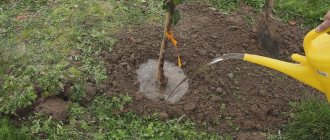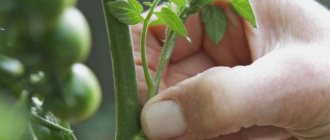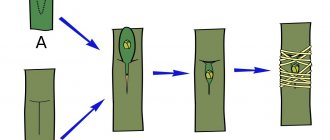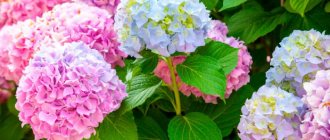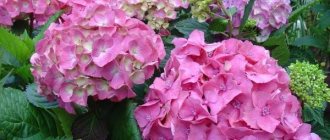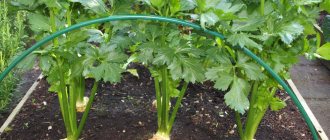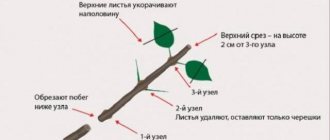- 2 How to properly plant hydrangeas in the fall
2.1 How to choose a landing site - 2.2 Preparing the site and soil for planting hydrangeas in the fall
- 2.3 Selection and preparation of planting material
- 2.4 Technology of planting hydrangeas in the fall in open ground
- 4.1 Video: Useful tips from an experienced gardener for planting hydrangeas
Features and timing of autumn planting of hydrangeas in open ground

Planting a large-leaved hydrangea in the fall is risky
For autumn planting, seedlings with a closed root system (usually sold in cups) are more suitable, since they are better developed. Then the chances of successful rooting of plants increase before the onset of the first frost. But it is better to plant very young seedlings in the spring. This also applies to the large-leaved variety with low frost resistance, which needs a solid shelter for the winter.
Estimated dates for the autumn planting of hydrangea by region:
- middle lane, Moscow region, Leningrad region - all September;
- southern Russia - until the end of October;
- Urals, Siberia - because of the short autumn, it is undesirable to plant a hydrangea in the fall, but the end of August will do;
- Ukraine and Belarus - late September-early October.
Many gardeners prefer to be guided by the lunar calendar. According to him, the most favorable days for planting hydrangeas in 2020 are 2–8, 12, 17, 18, 19 and 30 September.
Varietal variety
The hydrangea shrub has many species, the total number of which, including the most popular varieties, has long passed the mark of a hundred units. Unconditional favorites that do not require endless care are the least whimsical hydrangea varieties:
- panicle hydrangea;
- hydrangea;
- large-leaved hydrangea.
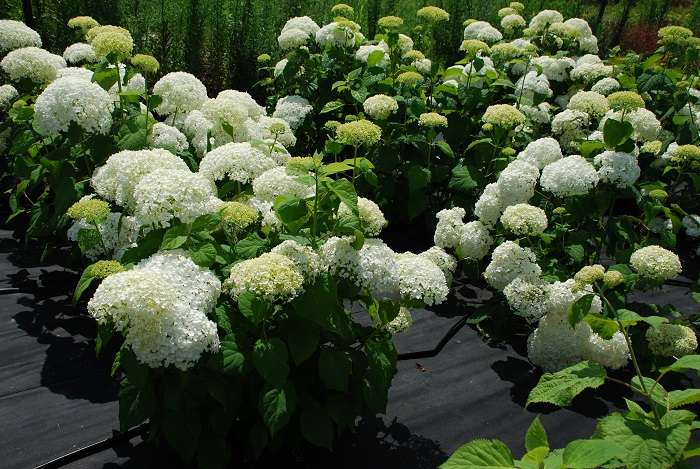

Hydrangea garden paniculata, photos of its species and varieties are presented below:
How to plant hydrangeas in the fall


One of the most important factors is the timing of planting.
The procedure is almost the same for treelike, paniculate and large-leaved varieties. The only caveat is that the tree hydrangea requires more free space, so it is placed at a distance of at least 2 m from other plantings.
Hydrangea reproduces well in the following ways:
- dividing the bush;
- layering (more suitable for the paniculate variety);
- cuttings.
It is possible to grow a plant from seeds, but this option is not very common due to its laboriousness.
How to choose a pick-up location


Hydrangea can be in the shade, while the plant will need less watering
This plant is thermophilic, but wintering cannot be avoided when cultivated in the regions of central Russia and Siberia. Therefore, a well-lit place is chosen, but with protection from the midday heat and draft. However, even in full shade, the hydrangea feels comfortable.
Panicle hydrangea, constantly exposed to direct sunlight, quickly fades. And you will have to water it more often, since it is moisture-loving.
Preparing the site and soil for planting hydrangeas in the fall
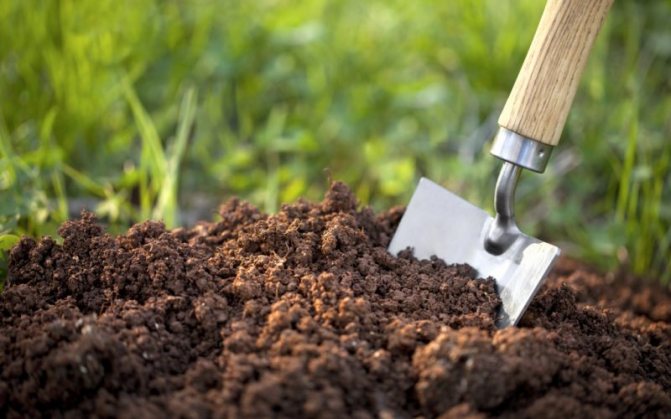

It is not recommended to add manure to the soil as fertilizer.
For planting these flowers, soil with a large inclusion of lime and fertilized with manure is not suitable. Loam and sandstone are preferred. But it doesn't matter.The main thing is that they are loose and fertile. Optimally, their pH is acidic or neutral.
To acidify the soil during digging, a mixture of the following components is introduced:
- humus and garden land (2 parts each);
- sand with peat (1 part each).
It is also recommended to add compost. Of the mineral compositions, superphosphate (about 70 g per 1 sq. M.) And potassium sulfate (25-30 g per 1 sq. M.)
The inflorescences of large-leaved hydrangea species turn blue in acidic soil, and in alkaline they acquire a pinkish tint.
The size of the planting pit depends on the age of the seedling and the amount of fertilizer applied. So, young bushes have enough space of 30x30 cm, for older ones (3-4 years old) - 50x50 cm. The distance between them during planting will depend on the species: tree-like, large-leaved - up to 1.5 m, paniculate - at least 2 m.
Selection and preparation of planting material


Do not cut the roots - this will lead to the death of the plant.
When buying hydrangea seedlings, pay attention to the following indicators:
- length - from 50 to 90 cm;
- age - at least 3 years;
- the presence of two or more strong shoots with live buds;
- no damage to the bark;
- well-developed root system.
It is better if the seedling is in a pot. The soil in it should be moderately moist.
Immediately before planting, the bush is soaked in a solution of potassium permanganate or any fungicide, which will serve as the prevention of fungal diseases.
Technology of planting hydrangeas in the fall in open ground
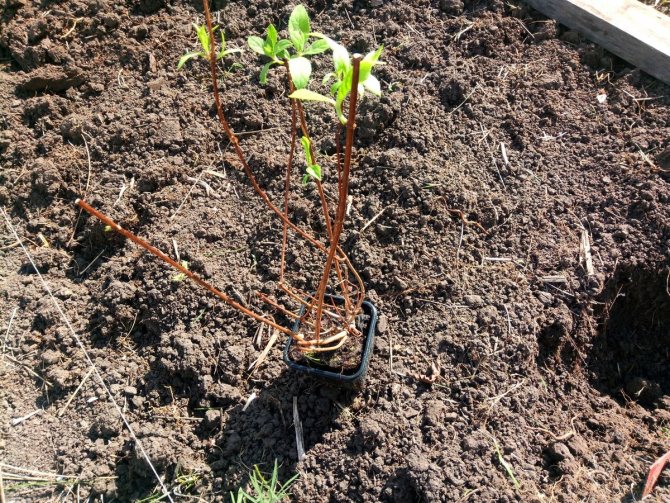

Experts say that it is better to pour water when watering than not to top up, since hydrangea is an extremely moisture-loving plant.
After all the preparatory activities, they begin landing, which takes place in the following order:
- A hole of the appropriate size is dug, where the nutrient mixture and acidifier are added.
- Pour a bucket of water.
- Take out the seedling from the pot, moistening the soil in it in advance.
- In the center of the hole, a small elevation is made from the ground and a bush is placed on it. Then the roots are evenly distributed on the sides.
- The voids are covered with soil and lightly slapped on top of it with your hands. The main thing is that the root collar is flush with the ground (when deepened, it begins to rot).
- At the end of the procedure, the bush is watered abundantly. If after a while the earth settles, then pour it.
The planting is completed by mulching the root space: a layer of peat or coniferous litter up to 7 cm thick is poured.
a brief description of
Lush and vibrant hydrangeas are very popular with gardeners. From Latin, the name of the flower is translated as "a vessel with water". This is a light and moisture-loving plant, and it loves water so much that it is better to water it more than underfill.
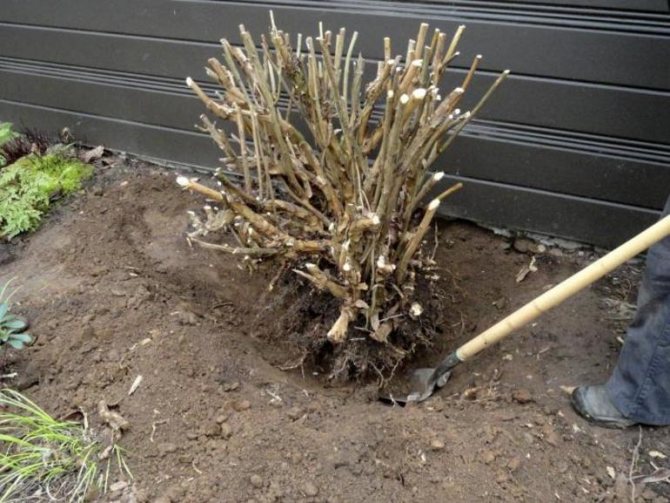

The genus Hortensievs has about 70-80 species... Many of them grow in East Asian countries. Shrub hydrangeas sometimes grow up to 3 meters high. Among the representatives there are similar to vines, which gradually entwine tree trunks.
Hydrangeas can be deciduous or evergreen. Among lovers of these plants, the first option is more often cultivated. The flowering of such shrubs begins in spring and continues until the onset of autumn. Their spherical inflorescences, collected at the ends of the stems, amaze with their splendor and variety of colors. The most common are:
When the flowering time ends, bolls with a large number of seeds appear on the bush. Depending on the composition of the soil, the shade of the inflorescences in blue and pink representatives may differ.
Colorful and lush flowers always attract attention, so hydrangea lovers often plant them in their backyards.
Common mistakes when planting hydrangeas


A serious approach to the preparatory stage will help to avoid many mistakes.
There are often cases when seedlings planted in open ground do not take root for a long time or die. There may be several reasons:
- When growing a seedling, a lot of fertilizing was introduced into the soil, and when transplanting to a new place, they were not enough due to poor soil. This happens if no potassium-phosphorus fertilizers have been added to the pit.
- Hydrangea was relocated from extremely acidic soil to slightly acidified one. Especially if a bush with open roots was taken.
- When planting a plant with a closed root system, an earthen ball was preliminarily shaken and the roots were cut. And this is strictly contraindicated.
- The root collar was greatly deepened, which leads to its decay. As a result, the plant begins to wither and soon dies.
- The seedling was not immediately planted, but kept for some time on the balcony.
It is also taken into account that the purchased flowering hydrangea bush, transplanted to a new place, must be gradually transferred from drip irrigation to regular irrigation, since it is drip humidification that is practiced in nurseries. Otherwise, the plant will soon fall ill due to a sharp change in regime.
All about the vegetation of seedlings
How to properly plant a hydrangea using several proven methods of experienced gardeners are described below:
- cuttings obtained by dividing can be bought on the market or in a specialized store in the fall. When digging a bush, it is divided into several parts, separating the shoots with roots. Choose strong branches with healthy roots, preferably in a container with soil. If during planting you notice damage to the roots, then dusting with crushed coal will prevent the entry of harmful microorganisms.
- young shoots growing at the edges are also separated and transplanted. First, the top layer of the soil is discarded, and then the tender sprouts are carefully separated from the mother bush.
- in September, the lower shoot is carefully laid on the ground and deepened into a 10–15 cm deep trench. This layer is pinned to the ground and buried by throwing mulch on top. During winter, it will germinate, take root and serve as an excellent planting material for the onset of spring.
- from one purchased seedling with several shoots we get up to 10 new ones. It is done like this: a depression is dug with a low slope and a root is placed in the deepest part of the hole. Trimmed shoots without leaves in the form of a fan are laid out on the slope area. Pour soil on top and throw in dry leaves for insulation. By spring, all the shoots will root and sprout, and a skilled gardener will plant them in different places on the site. This method is called seedling dropping.
5) Cuttings are a great way to propagate crops in the spring. This method is not used in autumn.
Care for bushes planted in autumn


You can reduce the risk of plant disease by pruning old branches
The subsequent care of the hydrangea is not particularly difficult and consists mainly of regular watering, if necessary. Since the weather is predominantly rainy in autumn, there is a high risk of developing fungal infections of the plant. Therefore, preventive treatment of plantings is carried out once a month (until the first frost): they spill the earth in the near-trunk circle with a manganese solution.
For tree hydrangea, potassium permanganate is an effective top dressing. As a result, the shoots become stronger and thicker.
It will be useful to acidify the soil at least twice during the autumn period with a mixture of citric acid, vinegar or any other means of a similar effect.


An adult plant can do without sheltering in the future.
A large-leaved hydrangea needs shelter for the winter. This can be done in two ways:
- Remove all foliage and prune the shoots to the fifth knot. Underdeveloped stems are cut to the base.
- The bush is tied with twine and bent to the ground, where it is fixed.Coniferous spruce branches are thrown on top and covered with lutrasil or other similar material.
Other varieties (tree, paniculate) do not need frost protection. But so that the shoots do not break under the weight of the snow cover, they are tied into a bunch. And also the bush is spud and a layer of mulch from sawdust or plant litter is scattered under it.
Preparing the plant for the winter period
In order to protect newly planted bushes from freezing, you need to cover it in the center with dry moss 30 centimeters up. If this is not possible, then sawdust, earth, straw, bark can be used as a shelter. In addition, it is necessary to cover the near-trunk soil with mulch and not be afraid to overdo it with a layer. Next, a twine is used to tie the bush, wrapped around with a spunbond and covered with spruce or pine branches on top.
As soon as the frosts begin to subside, it is necessary to remove the mulch so that the plant does not stifle and put fresh mulch instead. Since in the first years of life the plant grows green mass, the inflorescences should be cut off.
Hydrangea does not require special care and it is quite simple to do it in the garden, so it may be worth taking a closer look at it and planting it.





